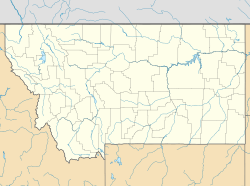Crow Creek Water Ditch facts for kids
Quick facts for kids |
|
|
Crow Creek Water Ditch
|
|
| Location | 201 Pennsylvania St. |
|---|---|
| Architectural style | Water supply system |
| NRHP reference No. | 01000323 |
| Added to NRHP | March 29, 2001 |
The Crow Creek Water Ditch is an old water system in Montana. It was built to move water from Eureka Creek to an area called Indian Creek. This water was very important for finding gold. People discovered gold in Indian Creek in 1866.
The ditch is located near Townsend, Montana. It was built between 1866 and about 1875. At first, it helped with gold mining. Later, farmers and ranchers used it to water their fields.
Contents
What is the Crow Creek Water Ditch?
The Crow Creek Water Ditch is a long channel that helped move water. It was designed to bring water to places where it was needed for mining and farming. Water was essential for "placer mining," which is a way to find gold by washing gravel.
How Was the Ditch Built?
The ditch is about 11 miles (18 km) long. It starts at a high point of 6,300 feet (1,900 m) and drops to 4,000 feet (1,200 m). Most of the ditch was dug by hand. Workers used shovels, picks, and axes.
Hand-Dug Sections
Two main parts of the ditch were dug by hand. These sections were about 3 feet (0.91 m) wide and 1 foot (0.30 m) deep. Imagine digging a channel this long and wide with just hand tools!
The Wooden Flume
One special part of the ditch was a "flume." A flume is like a wooden bridge or channel that carries water. This flume was 1,578 feet (481 m) long. It was built along the steep walls of Hassel Canyon. It was a very impressive part of the construction.
Natural Waterways
About 3 miles (4.8 km) of the ditch used natural gullies. These were like small valleys where water already flowed. This meant workers did not need to dig in these areas.
A Historic Landmark
About 8 miles (13 km) of the Crow Creek Water Ditch is listed on the National Register of Historic Places. This means it is an important historical site. It was added to the list in 2001.
What is Included in the Listing?
The listed area includes the two main hand-dug sections. It also has parts of the old wooden flume. You can also see the remains of a dam made from rubble stone.
Later Uses of the Ditch
In 1918, local farmers and ranchers created the Crow Creek Irrigation District. They used the ditch to bring water to their farms. This helped them grow crops and raise animals.
However, when Canyon Ferry Lake was created, the need for the ditch changed. The lake provided a new way to get water, so the old canals were used less often.



